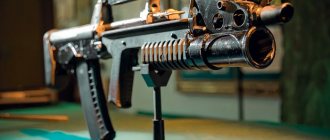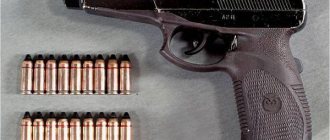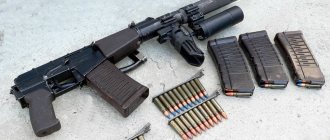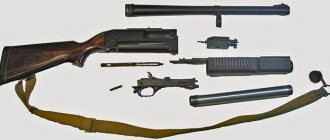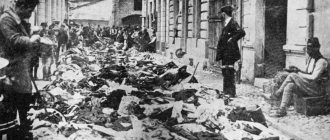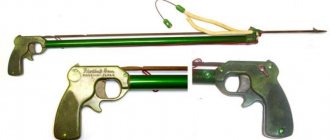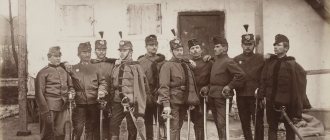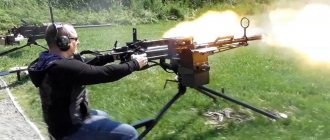The serbosek knife was invented in the Republic of Croatia during World War II. This is a reimagined version of a specific blade previously used in agriculture. Translated from Croatian, the name "serbosek" sounds like "serborez", because such blades were used to kill Serbs and Jews in concentration camps. Special action knives had a handle that was worn on the hand and a blade on the outside. There were both “handicraft” and factory-made silver cutters. The most famous manufacturer of this bladed weapon was the German one, which produced a batch of blades based on its sheaf tying knife.
The history of the killer knife
One of the first models of the Serbosek is practically no different from the peasant prototype.
The knife, intended for the mass murder of Serbs, appeared after a competition by the Croatian government for the best weapon for executioners, allowing one to slaughter hundreds of defenseless captives with as little fatigue as possible. The main role in the creation of this blade was played by Ante Pavelić, the leader of the Ustasha party and Poglavnik of Croatia from 1941 to 1945.
Having used such a weapon several times during punitive operations, the Ustasha improved it, replacing the blade with a longer and sharper one. It was this handicraft version of the peasant knife that became the model for the serial cutter.
Serbosek - bloody killer
The weapon was used by the Croatian Ustasha. This is an ultra-right movement based on Serbophobia and anti-Semitism. During the Second World War from 1941 to 1945, the movement was active in Croatia. The Ustasha created a huge number of concentration camps.
The product looks like a blade attached to a rough glove. The handle is a mitten that securely fixes the knife on the hand. This is what sets him apart from the rest. Size and shape do not have standard values.
Serbor cutter knife.
The name speaks to its direct application. Most were made in factories. But the Croats often created weapons using improvised means. Thus, there are 2 types:
- factory models - usually the length of the blade varied between 8 - 15 cm. Although in some cases it reached 30 cm or even more;
- homemade options - they are based on a German agricultural knife. It was produced starting in 1926. The length of the blade was up to 7 cm. The longer designs were based on a scythe.
Predecessor of the Croatian nationalist blade
One of the options for an agricultural knife for tying sheaves: weakly intended for killing.
A knife for tying sheaves is an agricultural hand tool designed for threshing sheaves. With its help, it was possible to easily cut the bandage of the sheaf without letting it out of your hands. Main characteristics of Serbosek's predecessor:
- The knife did not have a handle, but instead had a support plate or belt mount;
- The plate fit tightly to the palm and was attached to it using a system of belts or a leather glove;
- The blade is about 5-7 cm long, and it is curved and sharpened on the inside.
The tip is rounded, which made the sheaf knife safe to handle. The blade was not sharpened into a razor, as this could lead to injury to the owner.
Similar agricultural implements are not known in Russia; they were found in Germany, Austria and other places in Western Europe, where they had different names:
- Garbenmesse (chopping knife);
- Garben-Aufschneidemesser (thread cutting knife);
- Kornmesser (grain knife).
In cases of robbery against a peasant, he could protect himself with a blade in the palm of his hand, although this was very difficult to do with a short blade. Knives for tying sheaves lost their importance after the widespread introduction of mechanized harvesting, which eliminated manual tying.
DIY Serbosek
You can make the weapon yourself. For this you need:
- durable leather glove;
- blade 10 to 15 cm long. Preferably arched. It will be similar to the real sample. However, even a high-quality camping knife will do.
Manufacturing algorithm:
- The handle is removed, leaving the blade.
- The glove is turned inside out. A piece of dense material is sewn to the inside.
- Turn it inside out and cut a hole corresponding to the width of the blade. A slit is made in the palm area where the material is sewn.
- A blade is inserted into the pocket. Place the mitten on your palm and choose a good angle.
- Remove the blade from the glove and coat it with glue.
- After this, the final position is fixed.
Why Serbosek?
One of the sketches demonstrating how to turn a farm knife into an effective killing weapon
Nationalism is a terrible disease, it turns citizens of one country into irreconcilable enemies who defend their ideals with weapons in their hands. During World War II, the Ustasha happily took advantage of the ideas of Nazi Germany and declared several nations to be destroyed:
- Serbov;
- Gypsy;
- Jews
All of them were to be destroyed in the Jasnovac camp and other similar places.
The use of bladed weapons to kill infidels had ancient roots in Croatia and surrounding areas. The despised enemy died not from a military weapon, but from a household item, thereby indirectly confirming his status - a peasant or a slave. A sheaf knife, which had a long-established shape, was perfect for such purposes. Having received a batch of silver cutters, ordered by the Croatian government and manufactured during the war in Solingen, Germany, the Ustasha began to compete with each other in cruelty. After the war, the surviving Serbs recalled with shudder the terrible blades of the executioners.
Notes[ | ]
- ↑ 12
Jasenovacki logor smrti, Dr. Nikola Nikolic, 1948. - ↑ 1 2 3 Dr.
Mladen Colic. Takozvana NDH. Belgrade: Deltapres, 1973. - ↑ 1 2 Dedijer V.
Vatikan i Jasenovac, Dokumenti. - Beograd: Rad, 1987. - DHM Objektdatenbank (German). Access date: October 19, 2017.
- Eberhard Rondholz.
Zweierlei Erinnerung.
Jasenovac – Das kroatische Auschwitz (undefined)
.
DEUTSCHLANDFUNK
20. DEUTSCHLANDFUNK (August 28, 2009). — “Unseren Partisanen fiel einmal ein Schlachtmesser in die Hände. Es handelte sich dabei um ein 12 cm langes, gekrümmtes Messer, dessen Schneide sich am äußersten gekrümmten Rand befand. Die Klinge war an einer gewölbten, ovalen Kupferplatte und diese wiederum an einem dicken Lederarmband befestigt. Das Lederarmband, das ein Loch zum Durchstecken des Daumens aufwies, trug man um das Handgelenk. Die restlichen Finger blieben frei. An der unteren Kante zog man das Armband mit Lederriemen fest.” - Bloom H.
Wanted! : The Search for Nazis in America. — Quadrangle / New York Times Book Co., 1977. - Ristevski D.
Psihološka rehabilitacija Srbije. — Narodna knj. Alfa, 1997. - P. 148.
The terrible weapon of the Ustasha
Serborez - a weapon of death of the Second World War (1939-1945) and military campaigns in Yugoslavia (1991-2001)
During the Second World War, the Croatian Ustasha often staged cruel entertainment in prisoner camps. In one of the competitions, executioner Petar Brzica personally slaughtered 1,360 Serbs, receiving a gold watch from a Catholic chaplain for this. According to the Croatian executioner Zil Friganovic, the most effective were blades longer than 25 cm. The killers slaughtered people all night long, taking pleasure in the suffering of the Serbs.
Revival of the Mortal Instrument
During the collapse of Yugoslavia, Croatian nationalists revived many of the Ustasha traditions. In the early 1990s, in the fight against the Serbs and Bosnians on their territory, they actively used Serboseks. The behavior of the Ustasha became a model for them.
The Serbs showed many Russian war correspondents entire warehouses of such knives, sometimes improved: welded hammers, additional blades, sharp pins.
The Serbian military, remembering the fate of their ancestors in previous conflicts, was also not peaceful towards the Croats in 1991-2001.
Currently, Serboseks are kept in museums of the Second World War. There is an opinion that nationalist-minded Croats, who consider the Ustasha to be heroes, are trying to get hold of a silver cutter, which for them is a symbol of the fight for their country.
Serbosek. Genocide in Croatia
"Ustasha"
- an ultranationalist wing of the Croatian opposition against the centralized social structure of the Kingdom of Yugoslavia, in other words, a fascist organization against the unity of Yugoslavia, its forerunner was
the Croatian Party of Law
, which takes radical anti-Yugoslav positions. Ante Pavelić was in its ranks as secretary.
But the dominant political force in Croatia at that time was the Croatian Peasant Party
under the leadership of Stepan Radic. Then he was killed right in the parliament building by Serbian nationalists. King Alexander I dissolved parliament on January 6, 1929, declared the 1921 constitution invalid and proclaimed a royal dictatorship under which all nationalist movements were banned.
A day later, Ante Pavelić strengthened the Ustasha movement and emigrated to Italy, from which he conducted his subversive activities against the Yugoslav state, pursuing the only goal - to determine the geographical and administrative scope of the powers of local authorities.
The Ustasha saw themselves as fighters for independence from Serbian hegemony within Yugoslavia, setting as their goal the creation of an ethnically pure, independent Croatia. From the very beginning, the Ustasha movement was created to pursue a policy of genocide. Later, they increasingly took on fascist features, focusing on the examples of Hitler and Mussolini.
Under the pseudonym Hadjia, Ante Pavelić was the commandant of the Ustasha camp in Boveno (near Brescia), where he trained terrorists to carry out political assassinations. And in 1934, they, together with the Bulgarian nationalists VMORO, killed that same King of Yugoslavia, Alexander I, in Marseille.
The main area of activity of the Ustaše was the creation of support groups among Croatian emigrants, awaiting the possibility of seizing power in Croatia with German or Italian help.
After the occupation of Yugoslavia by German troops on April 10, 1941, the creation of the Independent State of Croatia (Nezavisna Država Hrvatska; NGH) was proclaimed.
Ante Pavelić took over as Governor of Croatia from 1941 to 1945.
with the support of the Nazis and Italian fascists.
The Germans occupied the most industrialized and densely populated areas and began to use their resources for their military needs. On June 6, 1941, the Germans also determined the final borders of the NDH: during Pavelic’s meeting with Hitler, the latter agreed to include Bosnia, Herzegovina and Sandzak in the NDH. The Ustasha declared Bosnia and Herzegovina “the original Croatian land.”
With the rank of governor, Pavelić concentrated all power in his hands and contributed to the creation of a cult of personality around himself. The Ustasha movement grew into the only party in the country. In parallel to the conscription-based army, following the example of the German SS, special military units of the Ustaše (Croatian: Ustaška vojnica) were created. The most famous fighting unit was the Black Legion (Croatian: Crna Legija) led by Major Jure Francetić.
On April 30, 1941, laws were passed according to which all non-Aryan citizens (Croats were also classified as Aryans) were outlawed, only an Aryan could become a citizen of the NGH, the rest were considered “belonging to the state.”
On the same day, the Laws on Race and the Protection of Aryan Blood and the Honor of the Croatian People were adopted, prohibiting interethnic marriages. At the same time, on August 12, 1922, Ante Pavelić married Maria Lovrenchevic, whose family included Jews.
Ethnic cleansing was widely used in the NDH, accompanied by the mass extermination of Serbs. And this was the most terrible manifestation of Nazism, Slavic brothers killed Slavic brothers, firmly believing that they were Aryans and the Serbs were not.
After the Ustasha came to power, policies were pursued aimed at deepening linguistic differences between Serbia and Croatia. The Croatian language was declared a separate language, never having anything in common with Serbian. Numerous neologisms were artificially invented (munjovoz - tram, slikopis - cinema, krilnik - general, etc.), which disappeared from use after the war.
Subscribe to us on telegram
Serbs, Jews, Gypsies and Croatian anti-fascists were imprisoned in concentration and extermination camps. The largest of the camps was the Jasenovac complex
, in which prisoners were killed with particular cruelty. Jasenovac was a conveyor belt of death. The greatest number of victims were among the Serbs. In Jasenovac they burned people alive en masse or cut up living people with special knives.
After the Croatian government of Ante Pavelic held a special competition on the question: “What kind of knife should be made so that the executioners could kill people as quickly as possible and at the same time be as tired as possible,” a
special knife was made for these cases - “Serbosek”, by a factory in the German city Solingen on special order.
Serbosek had a handle that fit on the hand, with the inscription "Gräwiso" on the leather part of the knife.
There were even competitions on the speed of killing with a “serbosek”.
The Ustasha, on the contrary, classified the Bosnian Muslims as Croats of the Muslim faith and officially gave them equal rights to Catholics.
“In a desperate struggle for its existence, Croatia shows at every step that it is ready to remain faithful to Catholic traditions and is ready to create a purer and better prospect for the Catholic Church in this part of the world...”
In relation to the Orthodox population, the Ustasha pursued a policy of extreme oppression, due to the situation where certain ethnic circles historically held political and religious views that were undesirable to the Ustasha.
A policy of forced conversion to Catholicism was practiced. Although membership in the Ustasha was prohibited to clerics, some former priests themselves took part in crimes.
Former Franciscan monk Miroslav Filipović from the Petricevac monastery participated in the extermination of 2,730 Serbs, including 500 children from neighboring villages. Subsequently, he became the main guard of the Jasenovac concentration camp and received the nickname “Brother Satan.”
One of the members of the Catholic official organization "Krizari" - Petar Brzica, working in the Jasenovac concentration camp, became famous as the "King of Serbicide". Using a silver cutter, he cut the throats of 1,360 prisoners in one day. For this, from the hands of the camp chaplain he received a gold watch, from the camp administration a silver service, and from the Ustasha who served with him in the camp, a baked pig and wine.
Franciscan Srečko Peric addressed the Croats with a speech:
“Croat brothers, go and slaughter all the Serbs, and first kill my sister, who married a Serb, and then all the Serbs in order. When you are done with this, come to my church, I will confess you and all your sins will be forgiven”(!!!)
Throughout the war, the Vatican maintained full diplomatic relations with the Ustasha state and had a papal nuncio in Zagreb.
(No, I don’t understand, it’s just how could one forgive the Vatican, first for so many centuries of witch hunts, then this?! They still walk in gold and no one has a conscience for this monstrous past of the Catholic Church... )
A year after the mass extermination of the Orthodox Serbian population, Archbishop Aloysius Stepenac presented the events of the genocide of Orthodox Christians in Croatia in his report to Pope Pius XII, blaming the Serbs, Chetniks and Communists: “No one will be allowed to attack the Independent State of Croatia and present the Croats in a bad light.”
The scale of the genocide in Croatia forced even Mussolini to provide refuge in Italy for Serbs and Jews fleeing the Ustasha regime. The Nazis also criticized the Ustasha for the Serbian genocide (since they supported the “friendly” puppet government of Milan Nedic in Serbia), but did not take practical action to stop the terror.
Until 1945, the Ustasha regime was a loyal ally of the Third Reich and sent its own divisions in support of the German attack on the Soviet Union. The main field of his military activity, however, was the fight against Tito's People's Liberation Army of Yugoslavia and the Serbian national-monarchist Chetniks.
The results of studies by Bogoljub Kočović and Vladimir Žerjavić on the number of victims in World War II in Yugoslavia indicate that
the Ustasha killed about 290 thousand of the 1.9 million Serbs living in the country, almost all 40 thousand Jews and 30 thousand Roma.
According to other sources, more than 400 thousand Serbs were killed.
The Croats killed by the Ustasha are a group of political and religious opponents of the regime, both Catholics and Muslims. It is believed that between 5,000 and 12,000 Croats died in Jasenovac alone.
After the victory of the Anti-Fascist Coalition in World War II in May 1945, many members of the Ustasha regime fled abroad. The remnants of the Ustasha, parts of the army (Domobrani) and Serbian and Slovenian nationalist detachments hostile to Tito surrendered to the British in today's Austria, but were handed over back to the Yugoslav communists, who shot most of them. The mass execution of the Ustasha in the Austrian city of Bleiburg received in history the name Bleiburg Massacre.
The organizer of the murder of hundreds of thousands of Yugoslav residents, Ante Pavelić fled Yugoslavia in 1945 (sentenced to death in absentia by the Yugoslav People's Court) with the help of Catholic priests. Pavelić arrived in Argentina in 1947 and lived until the late 1950s in Buenos Aires, where he served as security adviser to Argentine dictator Juan Perón. There he founded the so-called Croatian “government in exile”, not recognized by any state. Died December 28, 1959 in Madrid.
From the circles of Ustasha emigrants, terrorist underground groups were formed in Germany, the USA, Canada, Australia and Argentina and declared themselves the “Croatian liberation movement”. It planned and carried out assassinations on Yugoslav politicians, officials and ordinary people, as well as on its former members who left the movement.
Since Croatia's independence (in the early 1990s), some nationalist political groups have attempted to continue the Ustasha traditions. In 1991-1995, some Croatian formations fighting against Serbs and Bosnian Muslims proclaimed the Ustasha as their models.
With the connivance of the Croatian authorities of that time, the unofficial rehabilitation of the Ustashes began, many streets and objects were renamed in their honor, and the activities of the Ustashes were repeatedly portrayed in a positive tone in the press and on television.
Objects renamed in honor of figures of the Ustasha regime were returned to their previous names only in 2003 with the coming to power of Ivo Sanader, who belonged to the Croatian Democratic Community (HDZ), the largest Croatian party, which again advocated national independence
…
The initiator and active promoter of the policy of genocide was also the famous Croatian writer, minister of education and deputy dictator Pavelic, Mile Budak, who was executed by the partisans after the war. But in our again troubled times of either ignorance of history or revaluation of values, attempts are being made in Croatia to rehabilitate him, his nationalist anti-Serbian books are published in large editions.
Monument to the victims of Jasenovac:
Source


